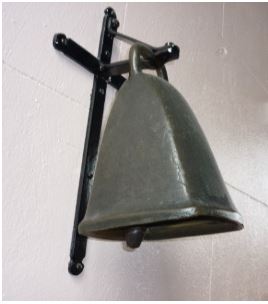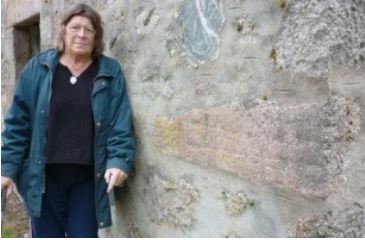Article 1 - St Ternan
Article 1 - St Ternan
Date of Death – Not known
Feast Day – 12th June
I deal first with St Ternan because some accounts of his life associate him with St Ninian in the 5th century, which would make him by far the earliest Christian Apostle on Deeside. Douglas Simpson, our most loved and trusted local historian said in his Rhind Lectures of 1941, “It is no part of my present purpose to embark upon the stormy waters of controversy that rage in that sea where so many goodly barks have foundered, namely the history of the Celtic Church in Scotland”. So it is with hesitation that I set sail on these waters, particularly on the most stormy waters surrounding St Ternan’s dates. If we accept Fenton Wyness’ account, we will believe that the first of the apostles to bring the Gospel to Deeside was St Ternan, and that Ternan was contemporary with St Ninian at Whithorn who founded his monastery at Candida Casa in the 5th century. There is some archaeological evidence that there was a penetration into Scotland of a sub Roman, pre-Columbian Church in the 5th and early 6th centuries, but that this extended no further north than Fife and the Mearns, with most of the evidence coming from south of the Antonine wall A.S.Waugh writing in his PhD Thesis (2003) dates St Ternan to between 600 and 800, with the likelihood of the 7th century being the time of his work in Banchory which is when most of the rest of Pictland came into contact with Christianity.
Whatever his date, Ternan was probably the first Christian evangelist on Deeside, and the founder of the Christian settlement which was to become the focus of the medieval Parish of Banchory Ternan. But although there are dedications to St Ternan in Arbuthnot, Slains, Findon and Belhelvie there is no doubt that the centre of his operations was the area of ground opposite the Island in the River Dee and just below where the River Feugh joins the Dee. Here he built a religious settlement called by the Britonic word a Banchor similar to the religious settlements in Wales and Northern Ireland both still known as Bangor. This one became known as Banchory Ternan, and while the Parish still uses that name, the township dropped the name Ternan, and became just Banchory.
There are three artifacts which have come down to us which are associated with St Ternan. The first and most famous is the hand bell Ronecht – “The Songster” – which hangs on the inner wall of the East Church in Banchory. Ronecht is said to have followed St Ternan on its own account all the way from Rome to Banchory and subsequently become the apostle’s most treasured possession. Within the Monastery at Banchory his relics were venerated until the Reformation, and apart from Ronecht these included his embalmed head, and his Book of the Gospels enclosed in a costly cumdach (book –shrine) of gold and silver. All three relics were lost at the time of the Reformation. However, about the year 1863 when the Deeside railway line was being built between the Monastery site and the river, workmen unearthed a square iron hand bell which may well have been Ronecht. Nothing more was thought of the discovery at the time, and the hand bell vanished. At least, so Fenton Wyness records in 1968. But that is not the end of the story, for a bell now hangs in the Banchory East Church of Scotland.
Questions may be asked whether St Ternan ever had a bell, miraculous or not. Stories of bells are common among Saints of that period, and the anecdotal evidence is strong to the extent that the Banchory Coat of Arms shows the Saint carrying just such a bell. Furthermore there is written evidence from 1485 when the Abbot of Arbroath granted to Alexander Simpson, Vicar of Banchory Ternan, all rights in the Bell of St Ternan and the profits from it. A.S.Waugh says that the bell is one of seven such hand bells, dated to c.900 (well after St Ternan’s life by any reckoning) belonging to the period of the union of the Picts and Scots in c.849, and that the bell in the East Church is undoubtedly the hand bell which represented Ternan’s legendary “Ronecht” during the medieval period.
What is not so clear is whether the bell hanging in the East Church is the same bell that was lost after the Reformation, was dug up in 1863, lost again, and then passed into the custody of Mrs Passmore, Mrs Roberts, and Mrs Waygood. The dedication on the brass plate hardly amounts to a provenance, and the bell itself, showing no sign of corrosion does not look like a bell that has spent several hundred years buried underground.
Two other artefacts are to be found in Banchory with strong anecdotal connections to St Ternan. On the south side of the main road going through Banchory between the Raemoir Road and the slip road going down to the cemetery, built into what used to be a garden wall, at National grid reference NO 705957 is a circled Celtic Cross which had been discovered in the kirkyard. A.S Waugh thinks this may be Columban rather than Pictish. If so this would date the wheel cross into the late 9th century and make it roughly contemporary with his dating of the bell.
It doesn’t really matter if the date of this circled cross is or is not contemporary with St Ternan. It is from the Age of the Saints, it survived the iconoclasts of the Reformation, and sometime in the 19th century it was built in to the garden wall of the then East Church Manse. Few people know about it unless it is pointed out to them, but to those who do, it is a direct link to that age when the Gospel came to Deeside.
Far more difficult to find are the two shafted crosses on a slab built in to the Tilqhuillie (Douglas) vault in the kirkyard itself. I expected the Tilquhillie vault to be reasonably easy to find. The Douglases are a major local family and have been for centuries, but two visits showed me nothing with their name on it. Time to get a better pair of eyes, I thought, so I enrolled Bev and we scoured both the local Kirkyard Guide , and the kirkyard itself, still without success. We went back to the library who tried hard but couldn’t help, but suggested we try the Council office who had a plan.



And there at last I found it on the plan, the biggest building in the yard which we had looked all round and which looked like a gardeners shed but on the plan it’s marked “Tilquhillie Vault”. I wont give the NGR for this stone because it’s so near the circled cross. You can see the kirkyard from the cross just down the hill to the south east. But here are pictures of what we found. Fig 3 is a drawing by Douglas Simpson of the two crosses, while Fig 4 shows the horizontal position of the incised crosses on red granite.
To build these two stones in to a garden wall and a burial vault doesn’t rank as conservation by today’s standards but it is conservation of a kind, and certainly better than letting them lie loose with the danger of being broken up to make road metal.
Following on St Ternan’s apostleship, we will move in the next chapter to St Erchard who was born locally, was educated by St Ternan at his Banchor, and is believed to have founded the church at Kincardine o’Neil. Like St Ternan, his story contains a miraculous bell, and also a similar difference of opinion about his dates.
© Hugh Cochran 2012

Discover more…
